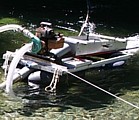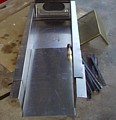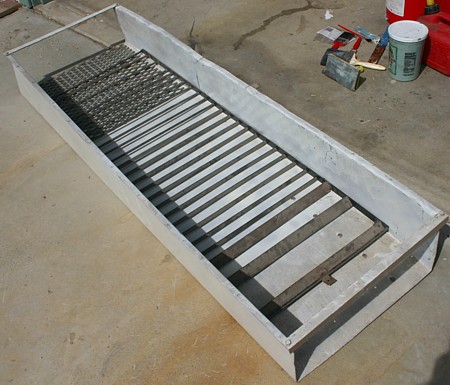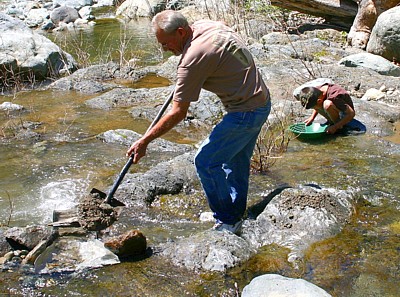
Build A Do It Yourself, Homemade Gold Sluice Box

 |
|
 |
Have you wondered if using a sluice box would help you find more gold? Here is how you can plan and build your own gold sluice box......
|
|
|||
| A sluice box lined with riffles is one of the oldest forms of gravity separation devices still being used today. They are simple and have been in use all across the world for thousands of years. A sluice is really nothing more than an artificial channel lined with devices to catch gold through which water flows moving the lighter materials such as clay, sands and gravels out of the sluice. The heavier materials like gold remain behind, trapped by the riffles. For many years, most sluice boxes were always home made affairs designed and built in the gold prospector himself. That meant there were a lot of strange designs as every guy had some idea about building a better mousetrap, or, sluice box. To this day, in the gold bearing regions of third world countries, prospectors design and build sluice boxes out the most unusual items – sometimes whatever materials are available locally. You don't really need any special sluice box plans - the exact size is really not all that critical, especially with one that is powered just by the flow of the river water. They come in all sizes and a can range from small, portable aluminum models used for prospecting all the way up to large sluice boxes hundreds of feet long, which are used at fixed installations in commercial operations. As an individual prospector, I recommend small, lightweight and portable as it allows you to take it wherever you need to. | |||
|
Making your own gold sluice is actually a very good beginning project for new prospectors in my opinion. Just take a close look at the many types of sluices being offered by the different manufacturers, and that will give you some good ideas about how you can build your own sluice box. It won't be difficult to get some ideas to make your own plans, but first you have to make some design choices about how you will build yours. |
|
|
|
| Sluice boxes can be made out of wood, aluminum, plastic or steel. Injection molded plastic is not really an option easily available to the do-it-yourself prospector, and that leaves steel (even though it has a tendency to rust) plus wood and aluminum. If possible, aluminum really is the preferred material for sluice construction. The advantage to steel is that it can be welded together. In developing plans for a homemade sluice box, the more time you spend thinking about your design, the better. You don't want to have to buy parts which you don't need, but on the other hand your slice box needs to work and catch the gold efficiently. A good plan and a good understanding of how a sluice box traps gold are important to your design. I think using miners moss underneath your riffles is a real important item for capturing that fine gold. Good riffles and good under lining are more important than length. Some guys want to make a hand sluice too long - three or four feet of riffle area is plenty to do a good job if it is properly designed. Commercial sluices running faster water that is pumped in need greater length and other considerations, but hand fed sluices running with river water don't need to be that long. That is why miners moss is used in the sluices of nearly all commercial suction gold dredges and placer mining operations using heavy equipment. Having a liner underneath the riffles is an important aid in catching small gold dust, and is very worthwhile. I went with miners moss under all the riffles in my sluice, and I strongly recommend it for you. | |||
|
The typical wooden homemade sluice is made of boards and varies in width from 8 to 18 inches, usually with a depth of 6 inches to a foot. A typical length would be in the three to 6 foot range. Use wood board not plywood or particle board as these are held together with glues that will fall apart after long exposure to water. Riffles can be made from half inch square dowel nailed about every 6 inches down the length of the sluice. The section without riffles in the top of the box about a foot long is often left for the spot where material shoveled in. This type of sluice box is very much like what many old timers built and it does catch gold, and is easy to build, but the problem is that it is hard to clean out at the end of the day because it absorbs water and gets quite heavy. In addition the abrasion of the flowing gravel will beat up the wooden riffles over time. It is also possible to create steel riffles that fit inside a wooden sluice, and in that case you can also use miners Moss or some similar material to line the bottom of the sluice underneath the metal riffles. Riffles can also be made from a sturdy gauge of expanded metal, but these are a bit heavier. Homemade sluices can also be made from lightweight sheet aluminum that has been folded into a "U" shaped trough. Wooden sluices tend to become waterlogged in increased greatly in weight after they have been in the water for time. This gives aluminum quite an advantage and it is certainly preferred in the construction of the homemade sluice. The trough of the hand fed sluice, whether made of aluminum or wood, is usually roughly the same size - in the range of about 8 to 12 inches wide, so on a sheet you'd need the width plus an extra 4 inches on each side. For those interested in making their own home made hand fed sluice box from aluminum with steel riffles as a do it yourself type of project, I can say that if you have any metal fabrication skills, you will find this an easy project. A little welding, a little metal folding and the project is done. If you purchase fairly thin aluminum sheet it will be possible to bend it yourself into the trough shape as a single piece (just don’t go too thin). The prospector's portable gold sluice box has an advantage that it can be quickly taken up and moved to a new location, as the prospector searches for spot with good gold. The grade slope when the sluice is set up usually ranges from about one to 2 inches per foot. |
|||
|
The riffles are really the most important part because they are the part of the sluice box that catches the gold. Riffles are often assembled from small slats of steel set at about 45° angle held in place by a rail on either side. They are best assembled by being welded together. They can also be made by bending part of an iron slat up at about 45 degrees. Take a look at the pictures with this article and you can see how I have welded my riffles together into a single easily removable piece. Keene and many other sluice box makers do the exact same thing. This makes the riffles easy to remove when it is time to clean the sluice out undercover the gold. Its handy and important to be able to clean you sluice out quickly and be able to see what you are getting for your efforts as far as gold. Removable riffles, whether in wooden or metal troughs are held down with bolts or wedges to keep them from moving around. Now my welds aren't pretty, but they do the job - they just need to be sturdy and hold the riffles in place. If this is what you wnat to do, I strongly recommend that you consider buying one of these welders. I have found mine so handy for building and repair stuff around the house that I have done up a whole web page on it. If you are seriously considering building your own sluice box (and perhaps other items), check out my page: Low Cost, Small Arc Welders For Home Use The more tools and fabricating skills you possess, the more likely it is that your home made dredge project will be a success. I have done up a page on the hand tools needed for this type of project, you can check it out at: Mining Project Necessary Tools If you would like to view some more information on how to operate a sluice box, be sure to check out my webpage on using one: How To Use A Sluice Box To Find Gold |
 A home made sluice box under construction. |
||
|
The hand sluice properly set up with smooth flowing water. |
 Prospecting with the Grandson - Priceless! |
||
Want to know a little bit more about this crazy prospector guy? Well, here's a little bit more about me, and how I got into prospecting: Chris' Prospecting Story
Gold Sluice, Gold prospecting, home made gold sluice, gold sluice design, gold sluice plans, building a gold sluice, gold sluice riffles, build your own sluice box,